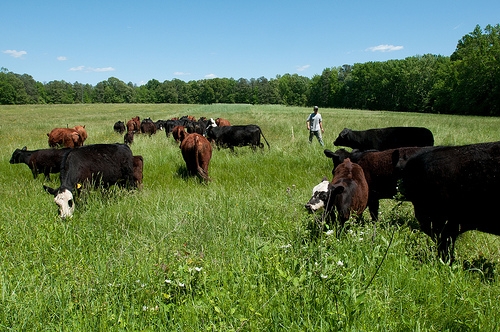What’s the biggest dietary change you can make to reduce global warming emissions? Eat less meat, especially beef. “But I love steak, chicken, and pork,” you say. “There must be another way to fight global warming!” Actually, there is. According to UCS’ new book, Cooler Smarter: A Practical Guide to Low-Carbon Living, eating less meat is just one of the many choices you can make to reduce your personal global warming emissions.
 This is part of a series on Cooler Smarter: Practical Steps for Low-Carbon Living.
This is part of a series on Cooler Smarter: Practical Steps for Low-Carbon Living.
Cooler Smarter urges all Americans to cut back on their global warming emissions by 20 percent this year and offers a menu of practical steps to reach that goal. As the book points out, you can make the biggest difference by first choosing to drive a fuel-efficient car and reduce home energy use. Next on the list, however, is what you eat—and when it comes to food, meat is the biggest climate offender.
Meat and Global Warming Emissions
It turns that the food sector accounts for 14 percent of U.S. global warming emissions and most of that is due to meat. Why is meat such a problem? Let’s start with beef, a trifecta of bad news on the warming front.

Happy cows grazing at the boyhood home of President Thomas Jefferson in Virgina. (Photo by Lance Cheung. Courtesy of USDA)
First, the stomach design that allows cows to digest raw plant materials makes them belch out methane, a gas that has 21 times more heat-trapping potential than carbon dioxide.
Second, although capable of thriving on grass, cows are are often gathered into confined animal feeding operations (CAFOs) and fed corn to fatten them up quickly. It takes about 7 pounds of grain to produce one pound of grain-fed beef and the emissions generated in corn production are part of the global warming tally for cows.
Finally, cows in CAFOs produce huge amounts of manure stored on site in piles or lagoons. When manure breaks down, even more methane is produced—yes, by a process similar to what goes on in a cow’s stomach.
Add all that up and it’s no surprise that cows have an outsized impact on global warming. In fact, a pound of beef is responsible for some 18 times the climate emissions of a pound of pasta.
Other meats, chicken and pork, are better choices than beef. Poultry and swine consume grain or other plant food but convert it into meat more efficiently than can cows. Also, their digestive systems don’t produce methane, a big climate plus. Poultry and swine, like cows, are often raised in CAFO’s where stored manure can generate methane, but on balance they are probably “cooler” choices than beef.
You Don’t Need to Become a Vegetarian
We Americans eat a lot of meat…on average 270 pounds per year, nearly 4 times the global average. You don’t need to become a vegetarian or a vegan to make a difference to the climate, just cut down on the amount of meat you eat. Think about something like meatless Mondays. They’ll add up.
What About Pasture-Raised Animals?
Since stored manure produces methane, you might wonder about choosing pasture-raised animals as a climate strategy.
While climate benefits fall on the positive side of the ledger, they may not be the most dramatic environmental benefits of pasture-based operations. According to Raising the Steaks, a recent report by my colleague Doug Gurian-Sherman, pasture-raised animals spread their own manure and so avoid the methane emission produced by stored manure. And well-managed pastures have the potential to sequester substantial amounts of carbon in soil, reducing the amount of carbon dioxide in the atmosphere.
But whether on pasture or in a feedlot, cows belch methane. In addition, cows (and pigs and chickens) raised in pasture-based systems often take somewhat longer to get to market, and so may generate more climate gasses per pound of meat.
Pasture-raised animals have other benefits. They are so healthy they rarely need antibiotics, providing compelling benefits to public health, and pasture systems can also substantially reduce air and water pollution. (Raising the Steaks)
So yes, pasture-raised beef, pork and chicken are probably cooler choices than CAFO-raised beef. But, sad to say for carnivores, the best way to take a bite out of climate change is to reduce meat consumption, especially beef.
